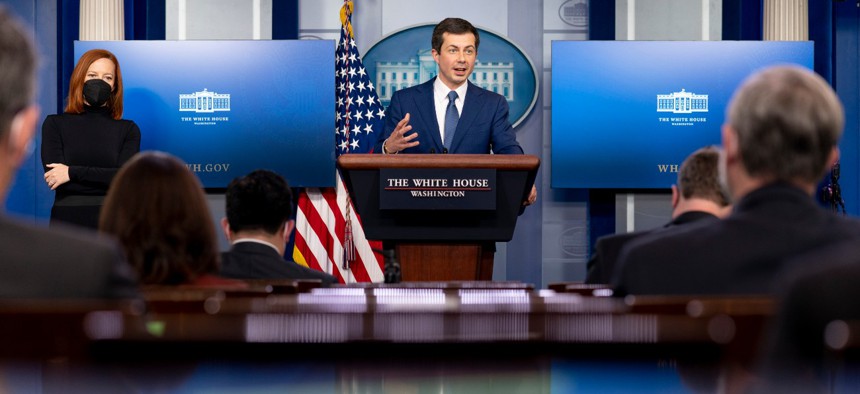
Mass transit is a big winner in Biden's budget. Transportation Secretary Pete Buttigieg, accompanied by White House press secretary Jen Psaki, left, speaks at a press briefing at the White House on April 9. Andrew Harnik/AP
The Biggest Agency and Program Winners in Biden’s FY 2022 Budget
The president's first budget provides significant funding boosts at nearly every agency across government.
President Biden on Friday put forward a preliminary budget proposal for fiscal 2022, outlining funding priorities that would comprise a substantial 16% increase in discretionary spending at non-defense agencies.
In announcing the blueprint, administration officials said the end of 10 years of spending caps required by the 2011 Budget Control Act provided an opportunity to replenish funds and staffing at agencies across government. While lawmakers passed bipartisan budget agreements to augment spending above those caps in every year since 2013, the administration said federal programs have been starved of adequate resources for a decade and it was striving to reverse that trend.
“This year’s appropriations process comes at a particularly important moment,” an administration official told reporters on Friday. “For the past decade, due to overly restrictive budget caps, our country has underinvested in core public services, benefits and protections that are incredibly important to our success.”
Every federal agency’s budget proposal previewed in the “skinny” document on Friday marked at least some spending boost, with the exception of the flat-funded Homeland Security Department. An official noted a president’s budget is merely an opening gambit in the upcoming negotiation with Congress and Biden’s proposal is meant to “start a discussion about the right size of discretionary spending.” The White House is planning to release its full fiscal 2022 budget in “late spring.”

Here is a look at some of the initiatives and agencies that would see the biggest increases under Biden’s proposal:
Education Department: Education would see a whopping 41% increase over its current funding level—the biggest uptick of any agency—with a $36.5 billion allocation. A sizable chunk of that boost would go toward Title I grants for schools that serve low-income families, which would see a 121% increase. The White House also called for $3 billion in additional funding for Pell Grants. Education saw the biggest net loss of staff during the Trump administration.
Public Health: To address future pandemic response and other priorities, the White House called for boosted funding to an array of public health programs. It identified $10.7 billion for combating the opioid crisis, a 57% increase. The Health and Human Services Department would see an overall boost of 23.5%, including a 22.5% increase for the Centers for Disease Control and Prevention. Biden called for the creation of the Advanced Research Projects Agency for Health (ARPA-H) to further cancer, diabetes and Alzheimer’s research at the National Institutes of Health, which would see an overall boost of 21%. The administration would double the current funding for the Community Mental Health Block Grant.
Climate Research and Resiliency: Biden has stressed since his inauguration that fighting climate change would be one of the central tenets of his presidency, and in his first budget he proposed $14 billion in new investments related to the crisis. About $4 billion would go to NASA, the Interior Department, the National Science Foundation and other agencies for climate research. After years of proposed mass cuts by the Trump administration, the Environmental Protection Agency would see a 21% increase. That would include $110 million for staffing, with the White House noting EPA shed nearly 1,000 employees over the last four years. The Energy Department would see $1.9 billion for its Building Clean Energy Projects and Workforce Initiative. The budget proposes a $600 million for purchasing electric vehicles and charging infrastructure, half of which would go to the General Services Administration.
Commerce Department: Commerce would see the second biggest increase over current funding, with a 28% jump. Spending would more than double at the National Institute of Standards and Technology, in part to stand up two new Manufacturing Innovation Institutes. The Economic Development Administration would see a 147% funding spike specifically for its assistance to coal country initiative. The National Oceanic and Atmospheric Administration would see a 25% funding boost, including $800 million for climate research and a 33% uptick for weather forecasting.
Mass Transit: Biden recently put forward a $2 trillion infrastructure plan that included investments in various forms of public transportation. He followed up that up in his budget blueprint, requesting a 35% increase for Amtrak, a 23% surge for the Capital Investment Grant program for “high quality transit” and an additional $625 million for new passenger rail.
Agriculture Department: USDA would see a 16% increase, including a 42% boost for fighting and preventing wildfires. Biden proposed a $1 billion increase for food safety net programs.
Interior Department: Interior was one of many agencies to experience a significant workforce decrease over the last four years and in its budget the Biden White House vowed to “restore critical agency capacity.” It proposed a 16% funding increase and said it would specifically address staffing at the U.S. Geological Survey and National Park Service, while also creating a Civilian Climate Corps.
Immigration Backlogs: The White House requested a $345 million appropriation for U.S. Citizenship and Immigration Services, nearly tripling the fiscal 2021 allocation for the largely fee-funded agency. After the agency threatened to furlough about 70% of its workforce last year under then President Trump, the Biden administration said USCIS would use the money to address its backlog of asylum cases. The Justice Department’s Executive Office of Immigration Review would see a 21% funding increase to address its 1.3 million case backlog and hire 100 immigration judges. The Offices of Professional Responsibility at both Customs and Border Protection and Immigration and Customs Enforcement would see a combined $84 million boost to more expeditiously address complaints against its workforce.







